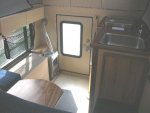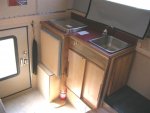You are using an out of date browser. It may not display this or other websites correctly.
You should upgrade or use an alternative browser.
You should upgrade or use an alternative browser.
The TARDIS - A Four Wheel Camper Build
- Thread starter Overland Hadley
- Start date
Overland Hadley
on a journey
Nice tank! I guess you have to tip it midway to get the other half of the water? That would be a good reminder of your consumption rate.
An outlet is on both sides, so no tipping. But you would know when you were about half way though your water, you would need to draw from the other side.
waynemaple
Observer
I could put a wood stove in the camper.

A schooner I sailed had one, it worked okay, but we made sure to cook a lot on cold nights.
Was this a FWC camper? I laughed so hard I sprayed coffee all over the laptop at the"banjo burning" comment!! I've had one of those drawing board moments to put a ice shanty stove in my FWC. Then the thought of burning wood over a tank of gas while sleeping crossed my mind. And where to vent it? I also don't play any wooden instruments so I don't have fuel to burn.:REOutCampFire03:
Stan@FourWheel
Explorer
The wood stove installation never got finished in that camper, so what you are looking at is only 1/2 finished.
The customer was wanting the wood burning stove, but we had never done that before, so they were still working in it.
It did have a chimney roof vent, but in the pictures there was no stove pipe up to the roof yet.
I don't know how they were going to finish it off ?
The forced air furnace we use in the campers is pretty darn good, simple, effective . . . as long as you have adequate 12v deep cycle battery power to keep it going.
BUT, I have seen a customer install something like a wood buring stove in a FWC shell model he built out himself.
It was awesome ! I thought it was a wood burning stove for some reason, but it looks like it actually is a marine style propane heater.
(thanks for the link ersatzknarf) !
He got just the shell model. Everything else you see inside he installed once he got the camper home.
I only wish I could build a camper interior like that in my garage.
I can fix most anything, but there is a reason I'm not out on the production line building the FWC's (laughs)

Check out the photos below. A clean & simple design.
.
.
The customer was wanting the wood burning stove, but we had never done that before, so they were still working in it.
It did have a chimney roof vent, but in the pictures there was no stove pipe up to the roof yet.
I don't know how they were going to finish it off ?
The forced air furnace we use in the campers is pretty darn good, simple, effective . . . as long as you have adequate 12v deep cycle battery power to keep it going.
BUT, I have seen a customer install something like a wood buring stove in a FWC shell model he built out himself.
It was awesome ! I thought it was a wood burning stove for some reason, but it looks like it actually is a marine style propane heater.
(thanks for the link ersatzknarf) !
He got just the shell model. Everything else you see inside he installed once he got the camper home.
I only wish I could build a camper interior like that in my garage.
I can fix most anything, but there is a reason I'm not out on the production line building the FWC's (laughs)
Check out the photos below. A clean & simple design.
.
.
Attachments
Last edited:
Terrainist
Explorer
Anyone know which wood stove that is in the photos directly above? Thx
ersatzknarf
lost, but making time
It looks like this one : http://www.dickinsonmarine.com/propheat.html
(but not wood burning...)
(but not wood burning...)
Anyone know which wood stove that is in the photos directly above? Thx
Terrainist
Explorer
Thanks a bunch.
ersatzknarf
lost, but making time
Hope that helped !
ersatzknarf
lost, but making time
Hi Stan,
You are most welcome.
Actually, I think that the first photo of that other (wood burning) stove might be made by the same company - look at the badge on the front, it looks just the same.
The trick with those sailboat propane heaters is getting the ventilation right (IIRC) and it looks like that fellow did so, but I am no expert on the subject.
I wish to have that kind of interior build skill set, too ! :Wow1:
You are most welcome.
Actually, I think that the first photo of that other (wood burning) stove might be made by the same company - look at the badge on the front, it looks just the same.
The trick with those sailboat propane heaters is getting the ventilation right (IIRC) and it looks like that fellow did so, but I am no expert on the subject.
I wish to have that kind of interior build skill set, too ! :Wow1:
It was awesome ! I thought it was a wood burning stove for some reason, but it looks like it actually is a marine style propane heater.
(thanks for the link ersatzknarf) !
<snip>
I only wish I could build a camper interior like that in my garage.
<snip>
Check out the photos below. A clean & simple design.
Overland Hadley
on a journey
Check out the photos below. A clean & simple design.
Hi Stan,
Do you remember what model that was built in? (Hawk, Eagle, etc) Trying to figure how much room he had to work with.
Thanks.
Overland Hadley
on a journey
Overland Hadley
on a journey
I found this information on catalytic heaters interesting. Sounds like a nice "warm heat."
(Link to original text)
(Link to original text)
CATALYTIC COMBUSTION
One of THE PLATINUM CAT's key features is its catalytic combustion process. Catalytic combustion is a unique chemical reaction differing from open- flame combustion in that a catalyst is used instead of high temperature to sustain the combustion process. In the classic flame combustion of most gas furnaces and space heaters, fuel normally burns when combined with oxygen and ignited by a flame at temperatures of at least 1200F. Once started, the process is self- sustaining as long as there is sufficient fuel and oxygen, and as long as the temperature remains above 1200F.
With catalytic combustion, the same reaction occurs except that a CATALYST, usually PLATINUM, is used instead of an open flame to sustain the combustion process, thus the term FLAMELESS COMBUSTION. The process is further unique in that the combustion is only about 750F, which is well below the ignition point of most materials, reducing the likelihood of accidental fires. In addition to being flameless, catalytic combustion produces sun-like radiant heat. Radiant heat, like light, is electromagnetic wave energy. It travels in straight lines at 186,000 miles per second, casts shadows, and is absorbed or reflected by matter. As the sun heats the earth, which in turn heats the atmosphere, THE PLATINUM CAT first warms people and objects which in turn heat the air in the living space. THE PLATINUM CAT floods an area around it with heat energy the same way a light floods an area with light. The intensity of the heat energy varies with the square of the distance it travels as does light, and it travels any distance until it is absorbed or reflected by people or objects in the room.
The design and construction of a catalytic combustion burner is substantially different from that of a classic flame burner. The framework of the burner is constructed much like a flat, open-faced pan. Gas fuel is fed into the back of the pan. The gas is then moved through layers of materials, usually ceramic fibers. These layers act as an insulator as well as a diffuser to provide even gas distribution. The diffused gas then penetrates the top layer (the catalytic pad) which is impregnated with the platinum catalyst. The heat-producing chemical reaction between the fuel, oxygen, and the catalyst takes place right at and slightly into the surface of the catalytic pad. A properly constructed catalytic burner, as used in THE PLATINUM CAT, converts virtually 100% of the fuel used to heat.
Overland Hadley
on a journey
Where are the propane tanks stored on a non-shell FWC? Is it a space that is sealed from the interior of the camper?
Thanks.
Thanks.
kcowyo
ExPo Original
On older models, on the driver's side wall, in a sealed box, accessible only from the outside. On newer models the box has been relocated to the rear of the camper, on the driver's side - bottom left, also only accessible from the outside.
2008 Hawk -

The doors on the newest models are slightly more narrow and taller as they've gone from using a single #10 propane tank, currently to dual 5# tanks for those who wish to leave appliances in the camper running on propane, while also using propane outside for a grill, lanterns, etc.
2009 Fleet -

.
2008 Hawk -

The doors on the newest models are slightly more narrow and taller as they've gone from using a single #10 propane tank, currently to dual 5# tanks for those who wish to leave appliances in the camper running on propane, while also using propane outside for a grill, lanterns, etc.
2009 Fleet -

.
Overland Hadley
on a journey
Thanks KC. Just the info and photos I needed.
Forum statistics
Members online
- Todtan
- Tharnacle
- WanderingBison
- ccfdcal
- mark5280
- Joe917
- gnlsn
- RDude
- 1nt3rn3tc0wb0y
- rmscs
- Gascan4X4
- SierraTheJKUR
- the deputy
- ahlgringo
- bkg
- aknightinak
- buyrovers
- MrModica
- Herbie
- ayindex
- matttahoe53
- Steve_382
- paachi
- Molipaq
- Baller
- icediver
- ready81
- MogsAndDogs
- Midwestfabs
- Ozarker
- LikeABoss
- AlwaysRoaming
- max4
- KSyota
- sundaeman
- Paddler Ed
- deserteagle56
- Kingsize24
- LivinAnAdvntr
- Voayageue
- beno02
- Czechsix
- Peter_n_Margaret
- RVRoams
- Hegear
- kmacafee
- Obsessed2findARuggedHybid
- Dakota1959
- S_Whit
- NatersXJ6
Total: 646 (members: 56, guests: 590)



